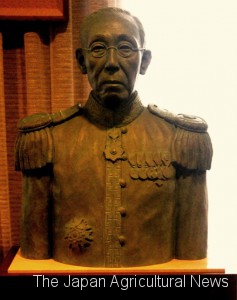Foster parent of 2 agriculture organization
Hisayoshi Kano, Vice President of Dainihon Sangyokumiaichuokai (association of cooperatives of Japan), is said “foster parent” of two agricultural organization, nokai (chamber of agriculture) and sangyokumiai (cooperatives) in the late Meiji.
Kano, after becoming a member of the House of Lords with the opening of Imperial Diet, served as a Kagoshima prefectural governor for 7 years since 1894 (Meiji 27). During the period of Governor, he focused on the development of agricultural technology and “even spared time to do touring of towns and villages in the prefecture, and opened the lectures and workshops in order to achieve the agricultural improvement. He organized nokai (chamber of agriculture) on each level of towns, villages, county, and prefecture, as a result, 500 thousand Goku of rice production amount of the prefecture suddenly raised up to the 900 thousand Goku, as a remarkable achievement.” (Great book of cooperative, second volume, Toraroku Miura, ” Kano Hisayoshi Kano and kenkin-ugen (donation of opinion and periphrastic)”= Ienohikarikyokai).
And Kano, who retired the governor and went back to Tokyo, in 1902 (Meiji 35), established Yugensekinin Iriarai shinyo-riyo-kumiai (limited liability cooperatives of credit and utilization) (current Johnan Shinkin Bank), based on sangyokumiai Law, at Iriarai mura of Ebara gun (Iriarai village of Ebara county (Omori, Ota)), where his former house was located. His house was provided for the office, he became president, and his wife became treasurer.
Kano was stalwart of both Nokai (chamber of agriculture) and sangyokumiai (cooperatives). He used the journal issued by nokai (chamber of agriculture), so as to support sangyokumiai (cooperatives) from the side. At the time, guidance and information publicity from the central to sangyokumiai (cooperatives) were made by “Chuonojiho (Central farming report)”, journal of Zenkoku nojikai (National Chamber of Farming). The journal helped the cooperation between sangyokumiai (cooperatives) and boosted the rise of its business.
Until Sangyokumiaichuokai (general association of cooperatives) issued “Sangyokumiaichuokaiho (newsletter of general association of cooperatives)” in November 1905 (Meiji 38), Chuonojiho (Central farming report) had been responsible for the journal role of de facto for sangyokumiai (cooperatives) movement. In it, Chuonojiho made a new column, “sangyokumiai (cooperatives) column”. Its direct personality was Kanji Sato (after the dean of Agricultural Faculty of Tokyo imperial University), at that time part-time secretary of Zenkoku nojikai (National Chamber of Farming). Sato, by being responsible for this column, had deep relationship with sangyokumiaichuokai (general association of cooperatives). Later he became canons of sangyokumiaichuokai (general association of cooperatives) through secretary.
Passion to inauguration for establishment of general association of sangyokumiai
First national council of the sangyokumiai officers and employees (the national congress of sangyokumiai, after), corresponding to now of the national congress of nogyokyodokumiai (agricultural cooperatives), was convened by the name of Hisayoshi Kano, Vice President of the association. Kano early claimed the need for the National Council, and prepared depending on Zenkoku nojikai (National Chamber of Farming), at last he served as the chairman at the first council. From the second time, the council was held by sangyokumiaichuokai (general association of cooperatives).
The Council was held for 3 days since May 10 in Tokyo. The council resolved the needs of the revision of sangyokumiai Law. Minister of Agriculture and Commerce, Keigo Kiyoura, also attended. Later, Minister’s attendance of congress became some fundamental principle.
To meet the demand from the sangyokumiai (cooperatives) side, the government embarked on a revision of the law. The highlights of primary revision in 1906 (Meiji 39) was permission for credit cooperatives to deal other business. Before the permission, people thought credit cooperatives likely to fail in the case of handling other business, so that it was forbidden.
However, “cooperatives financial business is limited to members, and can do credit check. In rural area, there are busy season and off-season. By serving seasonal business such as purchasing and sales business, credit cooperatives can adjust the on-off seasonal volume of operation.” (“History of development of sangyokumiai (cooperatives) evolution 1″) Considering such reason, it was to be recognized.
In the second revision of the law in 1909 (Meiji 42), sangyokumiairengokai (federation of cooperatives) and sangyokumiaichuokai (general association of cooperatives) were legally approved. Processing business of purchasing cooperatives was also recognized.
As a result, in 1910 (Meiji 43), legally approved sangyokumiaichuokai (general association of cooperatives) started to build full-fledged organization. Seven persons, including president and vice president at the era of Dainihon Sangyokumiai chuokai (association of cooperatives of Japan), Reijiro Wakatsuki (later Prime Minister, 1866 ~ 1949), Ryohei Okada (president of Dainihon Hotokusha, the Minister of Education, 1864 ~ 1934), were elected to Riji (board member). And three persons, including Gentaro Shimura ( 1867 ~ 1930), the second president of the association after, were elected to Kanji(auditor).
On May 6, 1910, the sixth “Dainihon sagyokumiaitaikai (national congress of sangyokumiai of Japan)” was held at the Aichi Prefectural Assembly Building in Nagoya city. On the second day of the congress, the opening ceremony of “sangyokumiaichuokai (general association of cooperatives)”, whose name was taken the character of “Dainhon (great Japan).” Regarding the officer personnel, president Hirata, Kano, and vice president Komatsubara were decided consecutive pitching.


